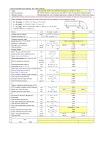
Shielded metal arc welding (SMAW)
- Shielded metal arc welding (SMAW), also known as manual metal arc (MMA) welding or informally as stick welding, is a manual arc welding process that uses a consumable electrode coated in flux to lay the weld.
- An electric current, in the form of either alternating current or direct current from a welding power supply, is used to form an electric arc between the electrode and the metals to be joined.
- As the weld is laid, the flux coating of the electrode disintegrates, giving off vapors that serve as a shielding gas and providing a layer of slag, both of which protect the weld area from atmospheric contamination.
- Because of the versatility of the process and the simplicity of its equipment and operation, shielded metal arc welding is one of the world's most popular welding processes.
- It dominates other welding processes in the maintenance and repair industry, and though flux-cored arc welding is growing in popularity, SMAW continues to be used extensively in the construction of steel structures and in industrial fabrication.
- The process is used primarily to weld iron and steels (including stainless steel) but aluminum, nickel and copper alloys can also be welded with this method.
- To strike the electric arc, the electrode is brought into contact with the workpiece in a short sweeping motion and then pulled away slightly.
- This initiates the arc and thus the melting of the workpiece and the consumable electrode, and causes droplets of the electrode to be passed from the electrode to the other .
- As the electrode melts, the flux covering disintegrates, giving off vapors that protect the weld area from oxygen and other atmospheric gases.
- To strike the electric arc, the electrode is brought into contact with the work piece in a short sweeping motion and then pulled away slightly.
- This initiates the arc and thus the melting of the work piece and the consumable electrode, and causes droplets of the electrode to be passed from the electrode to the weld.
- The heat produced by the arc melts the base metal, the electrode core rod, and the coating.
- As the molten metal droplets are transferred across the arc and into the molten weld puddle, they are shielded from the atmosphere by the gases produced from the decomposition of the flux coating. The molten slag floats to the top of the weld puddle where it protects the weld metal from the atmosphere during solidification.
Tungsten inert gas (TIG) welding
- Gas tungsten arc welding (GTAW), also known as tungsten inert gas (TIG) welding, is an arc welding process that uses a non consumable tungsten electrode to produce the weld.
- The weld area is protected from atmospheric contamination by a shielding gas (usually an inert gas such as argon), and a filler metal is normally used, though some welds, known as
- autogenous welds, do not require it.
- A constant-current welding power supply produces energy which is conducted across the arc through a column of highly ionized gas and metal vapors known as a plasma.
- GTAW is most commonly used to weld thin sections of stainless steel and light metals such as aluminum, magnesium, and copper alloys.
- The process grants the operator greater control over the weld than competing procedures such as shielded metal arc welding and gas metal arc welding, allowing for stronger, higher quality welds.
- However, GTAW is comparatively more complex and difficult to master, and furthermore, it is
- significantly slower than most other welding techniques
- Gas tungsten arc welding produces exceptionally clean welds no slag is produced, the chance inclusions in the weld metal is and the finished weld requires virtually no cleaning.
- Argon and Helium, the primary shielding gases employed, are inert gases. Inert gases do not chemically combine with other elements and therefore, are used to exclude the reactive gases, such as oxygen and nitrogen, from forming compounds that could be detrimental to the weld metal.
- Gas tungsten arc welding may be used for welding almost all metals — mild steel, low alloys, stainless steel, copper and copper alloys, aluminum and aluminum alloys, nickel and nickel alloys, magnesium and magnesium alloys, titanium, and others. This process is most extensively used for welding aluminum and stainless steel alloys where weld integrity is of the utmost importance.
- Another use is for the root pass (initial pass) in pipe welding, which requires a weld of the highest quality. Full penetration without an excessively high inside bead is important in the root pass, and due to the ease of current control of this process, it lends itself to control of back-bead size.
- For high quality welds, it is usually necessary to provide an inert shielding gas inside the pipe to prevent oxidation of the inside weld bead.
- Gas Tungsten Arc Welding (GTAW) is the current terminology approved by the American Welding Society, formerly known as "TIG" (Tungsten Inert Gas) welding.
Download Lecture Note's in PDF File With Below Given Download Link














0 Comments